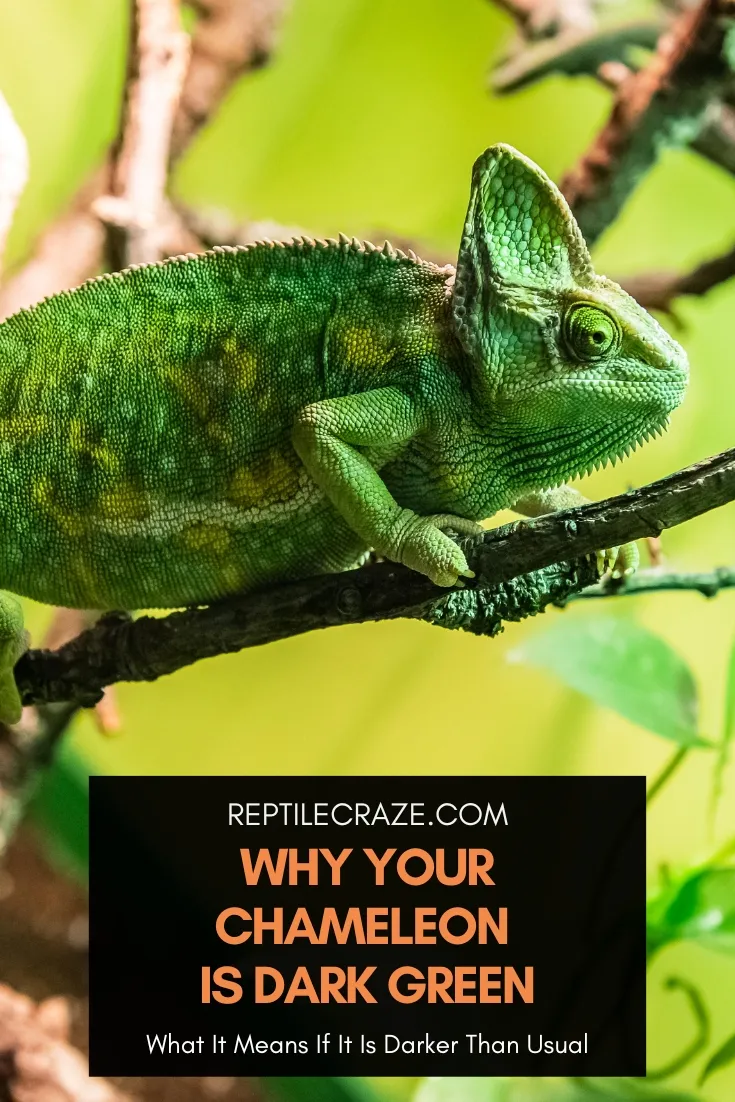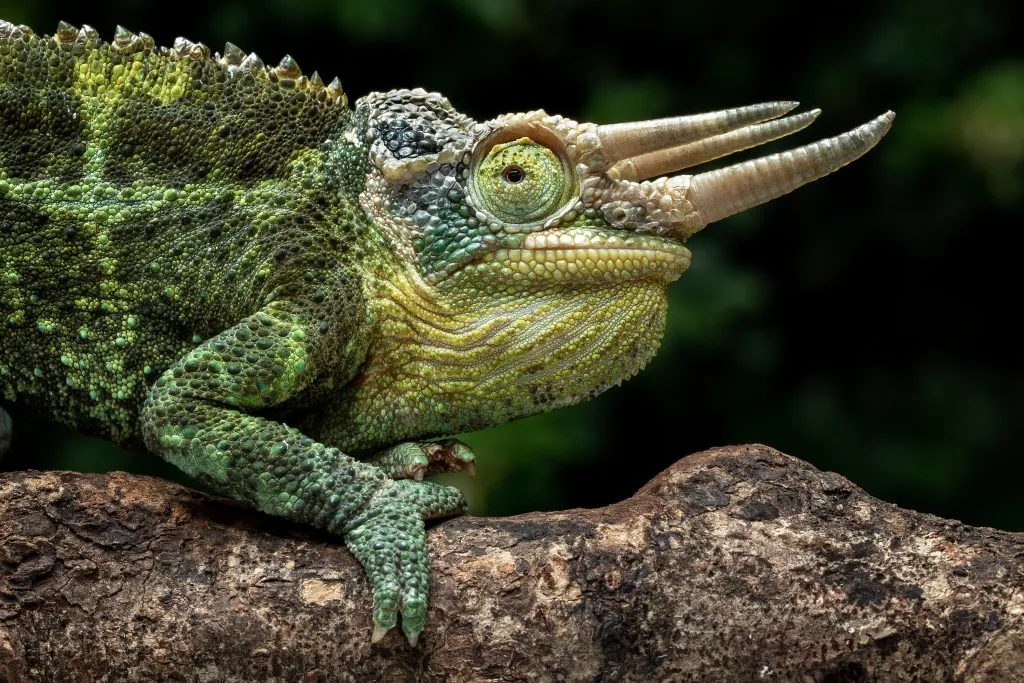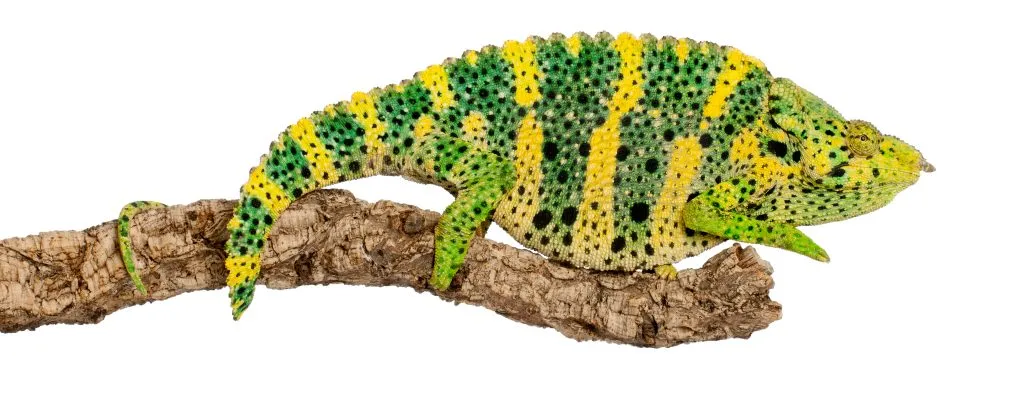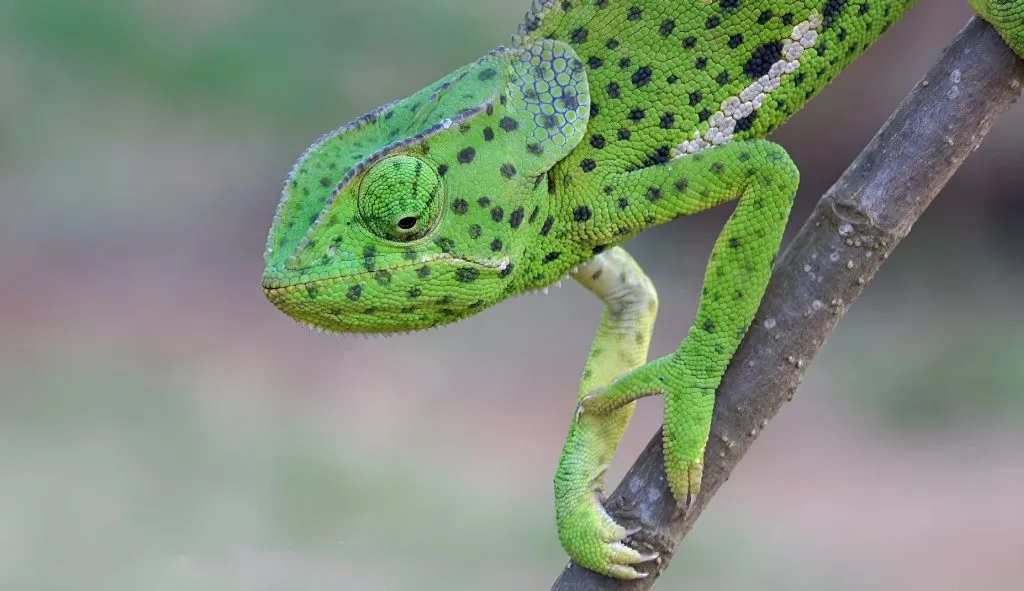
Did your Chameleon turn dark green in the blink of an eye? Well, this is actually very normal behavior for wild and captive-bred Chameleons. The rapid change in color can signify many things. Let’s determine whether this is natural or if veterinarian attention is needed
Most species of chameleons are naturally shades of green or brown. If your chameleon shows a darker green than usual, this could be caused by low temperatures in the
This article will help you determine whether your Chameleon needs more heat, less handling, or a visit to the vet.
Table of Contents
Typical triggers that can cause your Chameleon to turn dark green
To start, chromatophores are the pigmentary cells behind a Chameleon’s ability to change color. Although all species of Chameleons have chromatophores, not all species have the ability to vibrantly change color.
As listed below, some Chameleon species have a natural green shade to their skin and can only manipulate various shades of green.
- Male Carpet Chameleons
- Werner’s Chameleons
- Four-horned Chameleons
- Cameroon Sailfin Chameleons
- Elephant ear Chameleons
- Fischer’s Chameleons
- Common Chameleons
- Malagasy Giant Chameleon
- Female Cape Dwarf Chameleon
- Dead Leaf Chameleons
- Mossy Leaf Chameleons
- Female Jackson’s Chameleons
Let’s have a look at the reasons your chameleon may show a darker green than usual.
1. Thermoregulation
Thermoregulation is the most probable cause of the color change. When Chameleons change their color from a lighter shade to a darker shade or vice versa, they can heat or cool their body.
Chameleons are ectotherms and require external sources to regulate their body temperature. So, it’s not uncommon to see a cold Chameleon change to a darker shade to warm up.
If your Chameleon is dark green, brown, or black and is near their heat source, they are using the dark pigment to absorb heat faster. Shortly after, your Chameleon will return to its natural color.
2. Stress

Chameleons can show you they are stressed by showing different colors. A typical sign of stress is a dark shade of brown, green, or just black.
Although sourcing the cause of stress for your Chameleon may be hard, please take note of its current surroundings. Are there other animals? Loud sounds? A lot of foot traffic? New enclosure? Frequent handling?
These, and many more, are possible causes of stress that are easily fixable for your Chameleon.
Although diagnosing the stressor for your Chameleon may be a challenge, making sure they are warm, fed, and left alone are a few easy things you can do to see their normal color return.
Embracing a black dotted pattern is extremely common in some Chameleon species when showing signs of stress.
Is it the first time you have ever seen these black dots? Well, we will discuss some common causes of these mysterious black spots.
Tip: Did your chameleon just turned brown? We explain why that happens here!
Is your Chameleon dark green with black spots?
If the black spots come and go with temperature fluctuations, handling, or when feeding your Chameleon, these spots can be completely normal.
Depending on your species, a normal spotted pattern may only be embraced when a certain mood or change in color is happening.
Listed below are species that are known to have spotted patterns.
- Veiled Chameleons
- African Chameleon
- Common Chameleons
- Jackson’s Chameleons
- Flap-Necked Chameleons
- Meller’s Chameleons
- Malagasy Giant Chameleons
If your Chameleon species wasn’t listed above and does not naturally embrace a black spotted pattern, you could be looking at burns, physical trauma, or even bacterial infection.

Note: Not all spots are problematic; depending on placement, color, and texture, these spots could be as simple as a genetic mutation.
1. Burns
If your chameleon’s head, spine, horns, or for some species, casque, has black spots or black markings, you could possibly be looking at burns.
Although this isn’t very common, it is possible that your Chameleon has been spending too much time at their heat lamp.
If this is the case, you can either suspend the light over the enclosure or reduce the wattage of your heat lamp.
If you notice burns, bring your Chameleon to a veterinarian to get further medical treatment as open skin exposure can lead to infection.
2. Physical Trauma
Black markings or spots can also be the cause of physical trauma. If a bone was broken, scales were rubbed off, or your Chameleon got into a fight with another animal, the skin affected will turn black.
The best way to avoid trauma to your Chameleon’s skin is to make sure there are no sharp or roughed-up surfaces in your Chameleon’s enclosure, as this is the most common cause.
Depending on the size of these markings, they are usually confused with natural body marks. So, if your Chameleon has any interaction with other animals make sure to monitor them closely.
Housing your Chameleon alone and having minimal to no interaction with other reptiles is the best way you can prevent bite trauma inflicted on your Chameleon. (We show you how bad chameleon bites can be here)
The severity of the trauma inflicted on your Chameleon’s skin may require veterinarian assistance.

3. Bacterial Infection
If your Chameleon gets injured and the wound isn’t adequately treated, this could lead to a bacterial infection.
These types of spots will be very noticeable, usually showing bare/raw skin, blood, or pus.
You will need to seek veterinarian assistance immediately as these infections can turn fatal if not treated promptly.
Summary
The ability to change color in Chameleons is still a heavily researched science. This being said your Chameleon is most likely uncomfortable and is trying to express their discomfort.
The likelihood of your Chameleon being sick after expressing a dark shade is low, but if there’s a continuous expression of dark shades, seeking veterinarian assistance is heavily recommended.
In other words, if you keep your Chameleon happy, healthy, and warm, the chances of your Chameleon embracing dark shades are very low.
- Enchi Ball Python: A Unique and Stunning Morph of Python regius - March 27, 2025
- Emerald Tree Monitor: The Enigmatic Green Guardian of the Rainforest - March 26, 2025
- The Egyptian Cobra (Naja haje): A Fascinating Serpent - March 25, 2025
